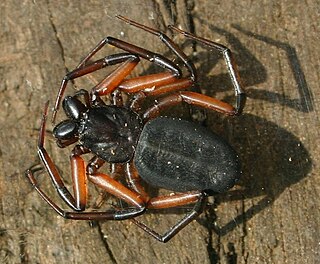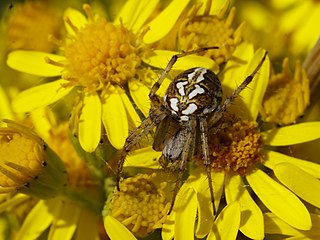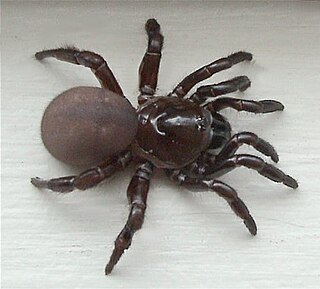
The wafer trapdoor spiders, family Cyrtaucheniidae, are a widespread family of spiders that lack the thorn-like spines on tarsi and metatarsi I and II found in true trapdoor spiders (Ctenizidae).

Wandering spiders (Ctenidae) are a family of spiders that includes the Brazilian wandering spiders. These spiders have a distinctive longitudinal groove on the top-rear of their oval carapace similar to those of the Amaurobiidae. They are highly defensive and venomous nocturnal hunters. Despite their notoriety for being dangerous, only a few members of Phoneutria have venom known to be hazardous to humans, but the venoms of this family are poorly known, so all larger ctenids should be treated with caution.

Myrmarachne is a genus of ant-mimicking jumping spiders that was first described by W. S. MacLeay in 1839. They are commonly called antmimicking spiders, but they are not the only spiders that have this attribute. The name is a combination of Ancient Greek μύρμηξ (myrmex), meaning "ant", and ἀράχνη (arachne), meaning "spider".
Belippo is a genus of jumping spiders.

Telamonia is a genus of spiders in the Salticidae family, found in rain forest, mostly in Asia and parts of Africa.

Trochanteriidae is a family of spiders first described by Ferdinand Karsch in 1879 containing about 180 species in 21 genera. Most are endemic to Australia though Doliomalus and Trochanteria are from South America and Olin and Plator are from Asia. Platyoides species exist in southern and eastern Africa, Madagascar, and the Canary Islands with one species, P. walteri, introduced to Australia.

Diaea is a genus of crab spiders first described by Tamerlan Thorell in 1869. Most species are found in specific locations except for D. livens, which occurs both in the United States and D. dorsata, which has a palearctic distribution. Adults are 5 millimetres (0.20 in) to 7 millimetres (0.28 in) and tend to hide in and around vegetation, especially flowers, where their color allows them to blend in to their surroundings.

Deinopis, also known as net-casting spiders, gladiator spiders and ogre-faced spiders, is a genus of net-casting spiders that was first described by W. S. MacLeay in 1839. Its distribution is widely tropical and subtropical. They catch their prey using a specially spun "net". The name is derived from the Greek δεινός (deinos), meaning "fearful", and opis, meaning "appearance", referring to their ogre-like faces. The spelling "Dinopis" is also found, but is regarded as an "unjustified emendation".

Neoscona, also called spotted orb-weavers and barn spiders, is a genus of orb-weaver spiders first described by Eugène Simon in 1895 to separate these from other araneids in the now obsolete genus Epeira. They have a mostly pantropical distribution and one species, N. adianta, has a palearctic distribution. The name was derived from the Greek νέω, meaning "spin", and σχοῐνος, meaning "reed".

Hogna is a genus of wolf spiders with more than 200 described species. It is found on all continents except Antarctica.

Idiops is a genus of armored trapdoor spiders that was first described by Josef Anton Maximilian Perty in 1833.
Hysterocrates is a genus of spiders in the family Theraphosidae, native to west and central Africa.

Ummidia is a genus of mygalomorph spiders in the Halonoproctidae family, and was first described by Tamerlan Thorell in 1875.
Cyphonisia is a genus of African brushed trapdoor spiders first described by Eugène Simon in 1889.
Ancylotrypa is a genus of African wafer trapdoor spiders that was first described by Eugène Simon in 1889. Originally placed with the Ctenizidae, it was moved to the Cyrtaucheniidae in 1953.












